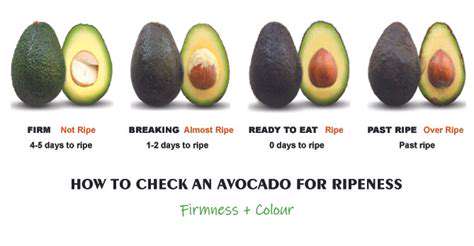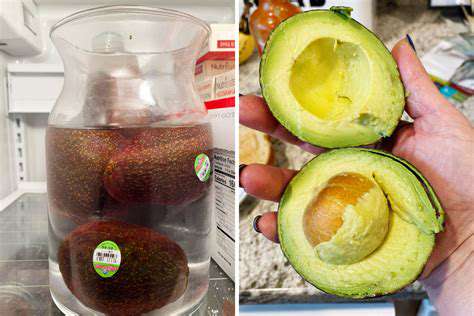How to Store Avocados: Ripening and Storing

Optimizing Ripening Conditions
Getting avocados to ripen perfectly involves paying close attention to their surroundings. Keeping the temperature steady is vital for uniform ripening. Aim for a range of 65-70°F (18-21°C) for best results. Temperature swings can cause uneven ripening, with some parts of the fruit ripening faster than others. Storing them in a place with good airflow helps prevent excess moisture, which can lead to spoilage.
Ethylene gas plays a major role in ripening. This natural plant hormone kickstarts the process. While avocados produce ethylene on their own, you can speed things up by placing them in a paper bag with a ripe banana, apple, or tomato. These fruits also release ethylene, which helps your avocados ripen faster.
Using Ethylene-Producing Fruits
Bananas, apples, and tomatoes are all great for speeding up avocado ripening. Their natural ethylene production makes them ideal partners. Putting avocados near these fruits in a sealed container or paper bag will noticeably speed up ripening. This approach is both safe and effective for quicker results.
Picking fruits that are already ripe is just as important for getting the best outcome with your avocados. Overripe fruits might transfer unwanted flavors or textures to the avocados, potentially affecting their quality.
Employing Proper Storage Techniques
How you store avocados during ripening makes a big difference in their quality and shelf life. Don't put them in the fridge too soon, as this drastically slows ripening and can leave you with an unpleasantly firm texture.
Instead, keep avocados at room temperature in a spot with good air circulation. A paper bag or fruit bowl works well for this. This method promotes even ripening and reduces the chance of early spoilage. Keep them away from direct sunlight or heat sources.
Monitoring Ripening Progress
Checking your avocados regularly helps ensure they reach the perfect ripeness. Gently squeeze the fruit - a slight give means it's ready. The skin color can also tell you a lot about ripeness. A deep, rich green usually indicates a perfectly ripe avocado.
If the avocado still feels too hard, leave it with ethylene-producing fruits a bit longer. If it's getting too soft, think about using it in recipes like guacamole or smoothies where texture matters less. Keeping an eye on the ripening process lets you make adjustments for the best possible results.
Preserving Avocado Goodness: Preventing Browning

Preserving Avocado's Freshness
Avocados, loved for their creamy texture and healthy fats, enhance many dishes. However, their delicate nature means they can spoil quickly without proper care. Knowing how to keep avocados fresh is key to enjoying their full flavor and reducing waste. Good storage methods can significantly extend an avocado's shelf life, letting you enjoy it at its best. Whether whole or cut, understanding the right way to store them helps maintain freshness and prevent browning.
Using these preservation techniques can help your budget and cut down on food waste. With proper handling and storage, you'll get more value from your avocados and enjoy tasty, nutritious meals all week.
Choosing the Perfect Avocado
Selecting avocados at just the right stage of ripeness is crucial for flavor and longevity. Look for fruits that feel firm but give slightly when pressed. Very hard avocados haven't developed their full flavor, while overly soft ones may be past their prime. Steer clear of avocados with bruises, dents, or soft spots, as these often indicate internal damage.
Optimizing Home Storage
How you store avocados at home makes all the difference in keeping them fresh. Keep unripe avocados in a cool, dark place like a pantry or fridge drawer. Once they're ripe, move them to a sealed container in the refrigerator to slow further ripening. This can add several days to their usable life.
Preventing Browning
Browning is a common issue with cut avocados. To stop it, immediately brush exposed flesh with lemon juice, lime juice, or another acidic liquid. This slows the enzymatic browning process, keeping your avocado pieces looking fresh and appetizing.
Another option is to store cut avocado in an airtight container with a damp paper towel at the bottom. The moisture helps prevent browning while keeping the avocado fresh.
Freezing Avocados
Freezing avocados is an excellent preservation method. First, peel and remove the pit. Cut the flesh into chunks and arrange them on a parchment-lined baking sheet. Freeze until solid, then transfer to freezer bags or containers for long-term storage. Don't forget to label and date them for easy identification later.
Freezing Avocado Pulp
Freezing mashed avocado is perfect for smoothies or dips. After freezing the pulp, portion it into freezer bags or containers. This makes it easy to grab just what you need. Freezing preserves avocado beautifully for future cooking needs. It's also a great way to avoid wasting leftover avocado.
Using Preserved Avocados
Preserved avocados work well in countless dishes. From guacamole and salads to smoothies and sauces, the options are nearly endless. Always consider the ripeness when using preserved avocados in recipes. If frozen, thaw them first for best results. With proper preservation, you can enjoy this versatile fruit year-round.
Freezing Avocados: Extending Shelf Life for Future Use
Freezing Avocados: A Step-by-Step Guide
Freezing avocados dramatically extends their usability, letting you enjoy them well beyond their normal shelf life. The secret lies in proper preparation. Choose avocados that are ripe but not too soft, as this affects the final texture. Overly soft avocados tend to become mushy after thawing. This method preserves both nutrition and flavor, making frozen avocados perfect for smoothies, guacamole, salads, and dips.
Start by washing and pitting the avocados. Slice them as desired, using plastic or wooden tools to prevent browning. Arrange the slices on a parchment-lined baking sheet in a single layer for even freezing. This prevents sticking and makes transferring to freezer containers easier later.
Preparing Avocados for Freezing
A key step before freezing is preventing browning. Soak the slices briefly in cold water with a splash of lemon juice or vinegar. The acid helps stop the oxidation process that causes browning. Make sure all pieces are fully submerged, then drain well to remove excess moisture.
Pack the prepared slices into freezer-safe bags or containers, removing as much air as possible to prevent freezer burn. Label clearly with contents and date. Portioning the avocado before freezing makes it easier to use later without thawing more than needed.
Thawing and Using Frozen Avocados
For best results, thaw frozen avocados overnight in the refrigerator. Avoid room temperature thawing, which can promote bacterial growth. Once thawed, use them in recipes where texture isn't critical, like blended dishes. The frozen texture actually helps create wonderfully creamy smoothies, dips, and spreads while maintaining the avocado's natural flavor.
- Smart Food Storage: Keep Your Groceries Fresh Longer
- Decadent Chocolate Chip Cookies: The Secret to Perfect Chewyness
- Baking for Beginners: Easy Recipes to Master
- Instant Pot Basics: Quick & Easy Pressure Cooker Meals
- Simple Pasta Dishes: Weeknight Wonders
- Seasonal Cooking: Fall Harvest Recipes & Produce Guide
- Vegetarian Meal Prep Bowls: Easy and Nutritious
- High Protein Breakfast Ideas: Fuel Your Day
- Preserving Summer Fruits: Canning Jams and Jellies
- Authentic Irish Stew: Hearty and Comforting
- High Protein Vegan Meals: Delicious Plant Based Power
- Baking with Alternative Flours: Gluten Free and Beyond